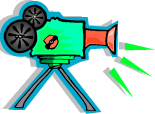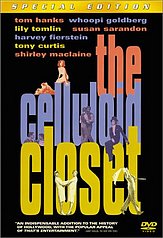

Knight at the Movies ARCHIVES

We're Here, We're Queer, and That Goes For Film, Too:
Reinventing the Movies
5-26-04 Knight at the Movies column
By Richard Knight, Jr.
Speaking about the paucity of gays and lesbians onscreen in the 1995 documentary The Celluloid Closet,
film historian Jan Oxenburg comments, “We are starved for images of ourselves on the screen.” When it comes
to mainstream Hollywood films, unfortunately, that’s still pretty much the case.
The Celluloid Closet is a primer for anyone wishing to see the way we were in the last 100 years of cinema
history. Mostly the way we weren’t – because for much of that time the “Moral Code” kept us off the screen.
Movie going was one of America’s great, shared pastimes (still is) and in the dark no one knew how intensely
you were looking at Cary Grant or Robert Redford, Marilyn Monroe or Sophia Loren. Films were a safe haven for
gays and lesbians to not only revel in the physical beauty of the actors on the screen but also, to let their
imaginations reinvent what they were seeing. It became part of the gay and lesbian film going experience to
wedge oneself into the place of the characters and the stories as they were played out on an alternate, lavender
screen.
When I was growing up, it was second nature to conceive of completely different scenarios for even the most
macho of screen archetypes. However, although John Wayne did have that girlish saunter, it was still tough to
picture him getting it on with Dean Martin or Robert Mitchum. But not so Michael Anderson, Jr., James Caan or
one of the Duke’s other too pretty younger generation gunslinger-toadys. When Caan wrestled with Michele
Carey in the barn in El Dorado it was easy stuff to transport oneself into her place in the hayloft, pinned under
Caan’s rippling biceps. Lesbians simply had to switch the fantasy around to make it work for them (and if her
character, named Joey MacDonald, doesn’t scream butch-femme, then Judy Garland was not married to lots of
gay guys.)
I saw El Dorado in 1967 when I was 10 and that was the first of hundreds of gay storylines and subplots that I’
ve superimposed on straight, mainstream films since. After awhile, it became a matter of course. I knew that
Luke Skywalker and Han Solo were meant for each other until Princess Leia showed up and spoiled everything,
for example. And show me the lesbian film fanatic that doesn’t read Foxes and Little Darlings as coming of age
dyke stories. When I talk with my gay and lesbian friends and mention this they all nod their heads – they find
the fantasy and subtext in the straight product, too.
With the rise of queer cinema it would seem that the need for this fanciful undertone would have evaporated but
the opposite has happened. As gay culture inches ever closer to the mainstream, it’s like a feeding frenzy for the
imagination is taking place. Besides, it’s much too much fun to let go of this whimsical gay conjecture. Thus, The
Lord of the Rings becomes the gayest movie of all time: Frodo and Sam were lovers. Gollum was their sexual
servant. Gandalf and Saruman were ex-lovers, taking out their messy break-up on each other. Saruman built
himself the studly Uruks for his own pleasure – just like Frank N. Furter built the blond Adonis in The Rocky
Horror Picture Show. Ad nauseum.
People tell me that Hollywood and independent cinema are world’s apart – that queer films are the only place
where we can see true images and stories of ourselves – that we must be patient and be happy because we’ve
taken gigantic steps in the last almost ten years since the release of The Celluloid Closet. Bla bla bla.
However, until the day – and I think it will happen in my lifetime – that some James Caan-Hugh Jackman-male
ingénue type erotic wrestles on the floor with his lover-mentor John Wayne-Denzel Washington-Thomas Jane
after they’ve killed the bad guys in a $150 million dollar mega blockbuster movie (or Julia Roberts with her
lover Kirsten Dunst) – and not in some nice little film seen by 15 people on Tuesday – my imagination is going to
continue holding sway.
So forgive me if I refuse to be satisfied seeing gays and lesbians shunted off into a cinematic subculture. Not
that I haven’t loved The Fluffer and But I’m A Cheerleader and Big Eden and look forward to more more more –
don’t get me wrong. It’s just that I know better. Life is grander, larger, richer, and much more colorful because
we’re part of it. New slogan: “We’re here, we’re queer and we’re in the movies.”
And have always been – one way or another.
Reinventing the Movies
5-26-04 Knight at the Movies column
By Richard Knight, Jr.
Speaking about the paucity of gays and lesbians onscreen in the 1995 documentary The Celluloid Closet,
film historian Jan Oxenburg comments, “We are starved for images of ourselves on the screen.” When it comes
to mainstream Hollywood films, unfortunately, that’s still pretty much the case.
The Celluloid Closet is a primer for anyone wishing to see the way we were in the last 100 years of cinema
history. Mostly the way we weren’t – because for much of that time the “Moral Code” kept us off the screen.
Movie going was one of America’s great, shared pastimes (still is) and in the dark no one knew how intensely
you were looking at Cary Grant or Robert Redford, Marilyn Monroe or Sophia Loren. Films were a safe haven for
gays and lesbians to not only revel in the physical beauty of the actors on the screen but also, to let their
imaginations reinvent what they were seeing. It became part of the gay and lesbian film going experience to
wedge oneself into the place of the characters and the stories as they were played out on an alternate, lavender
screen.
When I was growing up, it was second nature to conceive of completely different scenarios for even the most
macho of screen archetypes. However, although John Wayne did have that girlish saunter, it was still tough to
picture him getting it on with Dean Martin or Robert Mitchum. But not so Michael Anderson, Jr., James Caan or
one of the Duke’s other too pretty younger generation gunslinger-toadys. When Caan wrestled with Michele
Carey in the barn in El Dorado it was easy stuff to transport oneself into her place in the hayloft, pinned under
Caan’s rippling biceps. Lesbians simply had to switch the fantasy around to make it work for them (and if her
character, named Joey MacDonald, doesn’t scream butch-femme, then Judy Garland was not married to lots of
gay guys.)
I saw El Dorado in 1967 when I was 10 and that was the first of hundreds of gay storylines and subplots that I’
ve superimposed on straight, mainstream films since. After awhile, it became a matter of course. I knew that
Luke Skywalker and Han Solo were meant for each other until Princess Leia showed up and spoiled everything,
for example. And show me the lesbian film fanatic that doesn’t read Foxes and Little Darlings as coming of age
dyke stories. When I talk with my gay and lesbian friends and mention this they all nod their heads – they find
the fantasy and subtext in the straight product, too.
With the rise of queer cinema it would seem that the need for this fanciful undertone would have evaporated but
the opposite has happened. As gay culture inches ever closer to the mainstream, it’s like a feeding frenzy for the
imagination is taking place. Besides, it’s much too much fun to let go of this whimsical gay conjecture. Thus, The
Lord of the Rings becomes the gayest movie of all time: Frodo and Sam were lovers. Gollum was their sexual
servant. Gandalf and Saruman were ex-lovers, taking out their messy break-up on each other. Saruman built
himself the studly Uruks for his own pleasure – just like Frank N. Furter built the blond Adonis in The Rocky
Horror Picture Show. Ad nauseum.
People tell me that Hollywood and independent cinema are world’s apart – that queer films are the only place
where we can see true images and stories of ourselves – that we must be patient and be happy because we’ve
taken gigantic steps in the last almost ten years since the release of The Celluloid Closet. Bla bla bla.
However, until the day – and I think it will happen in my lifetime – that some James Caan-Hugh Jackman-male
ingénue type erotic wrestles on the floor with his lover-mentor John Wayne-Denzel Washington-Thomas Jane
after they’ve killed the bad guys in a $150 million dollar mega blockbuster movie (or Julia Roberts with her
lover Kirsten Dunst) – and not in some nice little film seen by 15 people on Tuesday – my imagination is going to
continue holding sway.
So forgive me if I refuse to be satisfied seeing gays and lesbians shunted off into a cinematic subculture. Not
that I haven’t loved The Fluffer and But I’m A Cheerleader and Big Eden and look forward to more more more –
don’t get me wrong. It’s just that I know better. Life is grander, larger, richer, and much more colorful because
we’re part of it. New slogan: “We’re here, we’re queer and we’re in the movies.”
And have always been – one way or another.
The essential starting point for gay cinematic history
